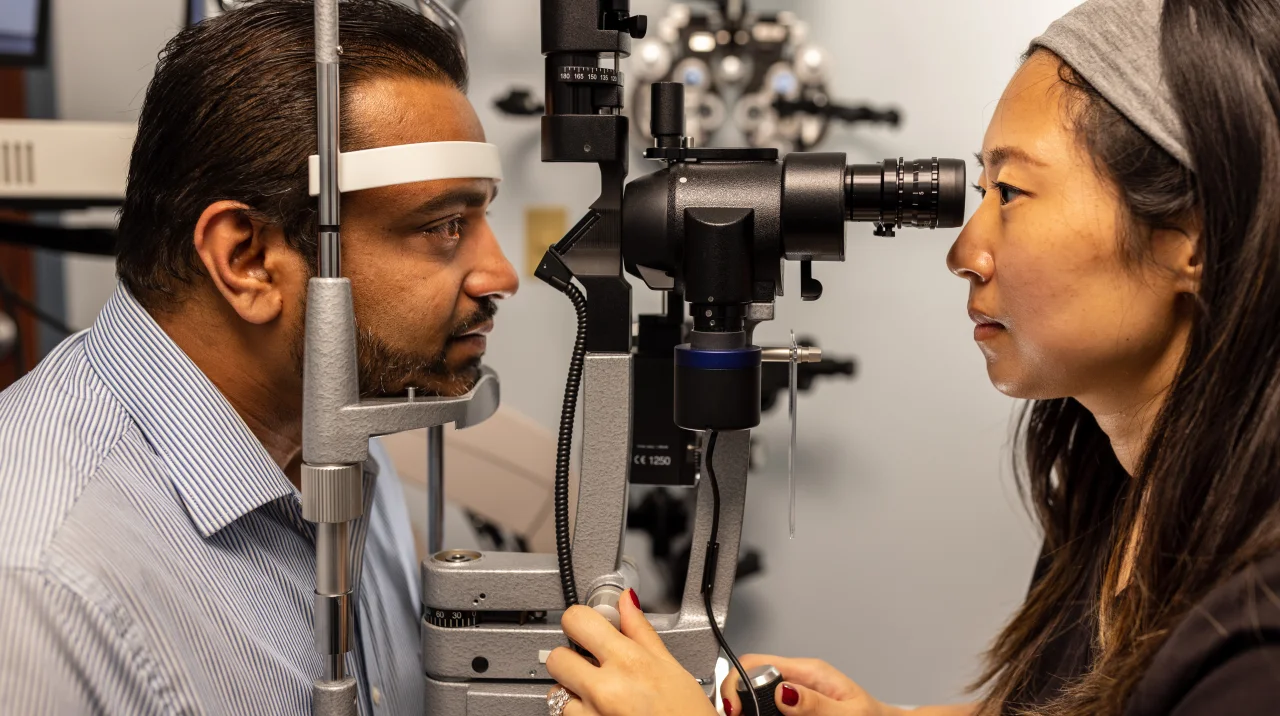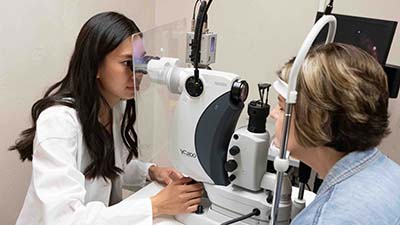Experience exceptional eye care and personalized service at 50 Dollar Eye Guy, located in Pensacola, Florida. Our team of friendly and professional doctors, including Doctors Grace and Joseph Tegenkamp and Dr. Jeanine Spoors, are dedicated to providing comprehensive eye exams and the best possible vision care. With a wide selection of fashionable eyewear and a commitment to spending the necessary time with each patient, we strive to ensure a comfortable and personalized experience for everyone who walks through our doors. Visit our website or call us today to make an appointment and meet our Pensacola staff.
Optometry Schools
Definition and Overview
Optometry schools are educational institutions that train individuals to become optometrists. Optometrists are healthcare professionals who specialize in the diagnosis, treatment, and management of eye-related conditions and vision problems. These schools provide the necessary theoretical knowledge and practical skills required for a successful career in optometry.
Optometry schools typically offer a Doctor of Optometry (OD) degree program, which is a four-year professional program. During the program, students learn about various aspects of eye health and vision care, including examining patients, prescribing glasses or contact lenses, managing eye diseases, and providing preventive care.
Admission Requirements
To gain admission to an optometry school, aspiring students must meet certain requirements. These requirements may vary between schools, but common prerequisites include completing a bachelor’s degree, completing specific undergraduate courses, and obtaining a competitive score on the Optometry Admission Test (OAT).
Additionally, many optometry schools require applicants to have shadowing or volunteer experience in an optometry or healthcare setting. This experience allows prospective students to gain insight into the profession and demonstrate their commitment to pursuing a career in optometry.
Curriculum
Optometry school curriculums are designed to equip students with the knowledge and skills necessary to practice as optometrists. The curriculum usually combines didactic coursework, laboratory work, and clinical rotations.
Didactic coursework covers a wide range of subjects, including anatomy and physiology of the eye, visual optics, ocular diseases, pharmacology, and clinical procedures. Laboratory work allows students to apply their knowledge in a hands-on setting, while clinical rotations provide practical experience in a supervised clinical setting.
The curriculum also includes courses on professional ethics, patient communication, and practice management, as these skills are crucial for providing high-quality patient care and running a successful optometric practice.
Accreditation and Licensing
Optometry schools must be accredited by the Accreditation Council on Optometric Education (ACOE) to ensure that they meet the required standards of education. Accreditation ensures that students receive a quality education and are adequately prepared for their future careers as optometrists.
After graduating from an accredited optometry school, individuals must obtain a license to practice optometry in their respective state. Licensing requirements vary by state but typically involve passing the National Board of Examiners in Optometry (NBEO) exams, which include written and clinical components.
It is important for aspiring optometrists to attend an accredited optometry school and meet all licensing requirements to ensure they are well-prepared and qualified to provide the highest level of care to their future patients.
Providing Comprehensive Eye Exams
Definition and Importance
Comprehensive eye exams are an essential part of maintaining eye health and ensuring optimal vision. These exams go beyond simple vision screenings, as they involve a thorough evaluation of various aspects of eye health, including visual acuity, eye movements, and the overall condition of the eyes.
Regular comprehensive eye exams are crucial for detecting potential eye diseases, identifying refractive errors, and monitoring changes in vision over time. They allow optometrists to diagnose and treat eye conditions at their earliest stages, leading to better treatment outcomes and improved quality of life for patients.
Components of a Comprehensive Eye Exam
A comprehensive eye exam typically consists of several components that assess different aspects of eye health and vision. These components may include:
-
Case History: The optometrist will gather information about the patient’s medical history, any existing eye conditions, and any symptoms they may be experiencing.
-
visual acuity Testing: This involves reading an eye chart to assess how well the patient can see at various distances.
-
Refraction: The optometrist determines the patient’s refractive error and prescribes glasses or contact lenses if necessary.
-
Binocular Vision Assessment: This evaluates how well the eyes work together, their alignment, and their ability to focus and track objects.
-
Eye Health Evaluation: The optometrist examines the external and internal structures of the eyes to check for any signs of disease, such as cataracts, glaucoma, or macular degeneration.
Diagnostic Tests and Procedures
In addition to the above components, a comprehensive eye exam may involve various diagnostic tests and procedures to gather more detailed information about the patient’s eye health. These tests can include:
-
Tonometry: This measures the pressure inside the eye and helps in detecting conditions such as glaucoma.
-
Visual Field Testing: This assesses the patient’s peripheral vision and can detect any abnormalities.
-
Retinal Imaging: This uses specialized cameras to capture images of the retina, allowing the optometrist to assess its health and detect any signs of disease.
-
Corneal Topography: This maps the shape of the cornea, which is essential for fitting contact lenses and diagnosing corneal conditions.
By conducting a comprehensive eye exam and utilizing diagnostic tests and procedures, optometrists can obtain a thorough understanding of their patients’ eye health and provide appropriate treatment or referrals, if needed.
Role of Optometrists
Optometrists play a vital role in providing comprehensive eye exams. Through their extensive training and expertise, they are able to evaluate and manage various eye conditions, assess visual acuity, and prescribe corrective eyewear or contact lenses. They can also detect and monitor conditions that may require specialized care from ophthalmologists or other healthcare professionals.
In addition to their clinical skills, optometrists are also trained to educate patients about proper eye care and preventive measures. They may provide guidance on maintaining good eye health, managing chronic conditions, and protecting the eyes from potential hazards.
By offering comprehensive eye exams, optometrists contribute to the overall well-being and quality of life of their patients. Their expertise and patient-centered approach ensure that individuals receive the necessary care to maintain healthy eyes and clear vision.

This image is property of cdn-eyecare.berkeley.edu.
Vision Care Services
Prescription Eyewear
Optometrists are highly skilled in prescribing and fitting glasses to correct refractive errors and improve visual acuity. They utilize their knowledge of optics and visual perception to determine the appropriate prescription, taking into account factors such as the patient’s vision needs, lifestyle, and ocular health.
Prescription eyewear includes a wide range of options, including single-vision lenses, bifocals, progressive lenses, and specialized lens coatings to enhance visual comfort and minimize glare. Optometrists also have expertise in frame selection, ensuring that patients find glasses that not only correct their vision but also suit their style and preferences.
Contact Lens Fitting
Contact lenses provide an alternative to traditional eyeglasses for individuals who prefer a more discreet and natural vision correction option. Optometrists are trained in fitting contact lenses and determining the specific type, material, and prescription that best suits each patient’s needs.
Contact lens fitting involves assessing the patient’s eye health, corneal shape, and tear film quality to ensure a proper fit and optimal comfort. Optometrists also provide instruction on contact lens insertion, removal, and proper hygiene practices to minimize the risk of complications.
Regular follow-up visits are an essential part of contact lens fitting, as they allow optometrists to monitor the patient’s eye health and address any concerns or issues that may arise.
Treatment for Eye Conditions
Optometrists are qualified to diagnose and manage a wide range of eye conditions, including dry eye syndrome, conjunctivitis, allergies, and minor injuries. They may prescribe medications, recommend lifestyle modifications, or provide other forms of treatment to alleviate symptoms and promote healing.
For more complex eye conditions or diseases, optometrists may collaborate with ophthalmologists or other specialists to ensure patients receive the most appropriate care. This collaborative approach allows for comprehensive and coordinated management of patients’ eye health.
Preventive Eye Care
Preventive eye care is a crucial aspect of optometry, aimed at preserving and maintaining good eye health. Optometrists emphasize the importance of regular comprehensive eye exams, even for individuals without apparent vision problems. Through these exams, potential issues can be detected early, allowing for timely treatment and intervention.
In addition to exams, optometrists may provide guidance on maintaining proper eye hygiene, protecting the eyes from harmful UV rays, and practicing healthy habits to reduce the risk of eye diseases and vision problems.
By offering a range of vision care services, optometrists ensure that individuals of all ages have access to the appropriate eyewear, treatment, and preventive measures to support their visual health and overall well-being.
Technological Advancements
Digital Imaging and Diagnostic Tools
technological advancements have significantly enhanced the field of optometry, allowing for more accurate and efficient diagnosis and treatment of eye conditions. Digital imaging technologies, such as optical coherence tomography (OCT) and fundus photography, provide detailed images of the eye’s structures, allowing optometrists to detect and monitor conditions such as macular degeneration, diabetic retinopathy, and glaucoma.
Diagnostic tools such as automated visual field analyzers and corneal topography systems provide objective measurements and data that aid in diagnosing and monitoring various eye conditions. These tools not only improve diagnostic accuracy but also enhance patient care by providing a more detailed understanding of the patient’s eye health.
Telemedicine in Optometry
The emergence of telemedicine has revolutionized the field of optometry, particularly in remote or underserved areas. Telemedicine allows patients to receive virtual consultations and follow-ups with optometrists, eliminating the need for in-person visits for certain routine eye care services.
Through telemedicine, optometrists can provide advice, monitor treatment progress, and address non-emergency concerns remotely. This expands access to vision care, particularly for individuals who may face barriers such as transportation issues, limited mobility, or living in rural areas without easy access to optometric services.
Advances in Contact Lens Technology
Contact lens technology has advanced significantly in recent years, offering improved comfort, clarity, and convenience for contact lens wearers. Optometrists stay abreast of these advancements and are skilled in fitting and prescribing the latest contact lens options to meet the unique needs and preferences of their patients.
Advances in contact lens materials, such as silicone hydrogels, allow for increased oxygen permeability, reducing the risk of complications and providing greater comfort for extended wear. Additionally, the development of multifocal and toric contact lenses enables individuals with presbyopia or astigmatism to enjoy clear vision without the need for glasses.
By incorporating technological advancements into their practice, optometrists can offer their patients the most up-to-date and effective solutions for vision correction and eye care.

This image is property of www.aoa.org.
Research and Innovation
Advancements in Eye Disease Treatment
Optometry research plays a vital role in advancing the understanding and treatment of various eye diseases and conditions. Ongoing research efforts focus on developing new therapies, improving treatment options, and exploring innovative approaches to managing eye health.
Advancements in eye disease treatment have led to the development of novel medications, devices, and surgical techniques. For example, the introduction of anti-vascular endothelial growth factor (anti-VEGF) drugs has revolutionized the treatment of conditions such as age-related macular degeneration and diabetic retinopathy, offering improved outcomes and preserving vision.
Optometrists involved in research contribute to the advancement of knowledge in the field and have the opportunity to participate in clinical trials, contributing to the development of new treatments and therapies.
Exploring Vision Correction Techniques
Optometry research also focuses on improving vision correction techniques, such as laser refractive surgery and orthokeratology. These techniques aim to provide individuals with clear vision without the need for glasses or contact lenses.
Laser refractive surgery, including LASIK and PRK, reshapes the cornea to correct refractive errors such as nearsightedness, farsightedness, and astigmatism. Orthokeratology involves the use of specially designed contact lenses to gently reshape the cornea overnight, allowing individuals to enjoy clear vision during the day without the need for corrective lenses.
Optometrists contribute to research in these areas by evaluating patient outcomes, exploring new technologies and approaches, and educating patients about the potential benefits and risks of these vision correction techniques.
Improvements in Optometric Equipment
Advancements in optometric equipment have contributed to more precise and efficient eye examinations and treatments. Innovative tools such as digital retinal cameras, automated visual field analyzers, and advanced diagnostic software enhance the accuracy and reliability of various optometric procedures.
Digital retinal cameras capture high-resolution images of the retina, allowing for detailed analysis and documentation of any abnormalities. Automated visual field analyzers provide objective measurements of peripheral vision, aiding in the diagnosis and monitoring of conditions such as glaucoma.
Optometrists keep abreast of the latest advancements in optometric equipment to ensure they can provide the best possible care and diagnostic capabilities to their patients.
Collaboration with Other Healthcare Professions
Importance of Interdisciplinary Approach
Optometrists recognize the importance of collaboration with other healthcare professions to provide comprehensive and coordinated care to their patients. By working together with professionals from different disciplines, optometrists can address the diverse needs of their patients and ensure optimal visual health.
Interdisciplinary collaboration is particularly important in cases where eye conditions require specialized care beyond the scope of optometry. By communicating and collaborating with ophthalmologists, primary care physicians, and other healthcare professionals, optometrists can facilitate seamless referrals, share information, and develop tailored treatment plans for their patients.
Co-managing Patients with Ophthalmologists
Some eye conditions, such as cataracts, glaucoma, and retinal diseases, require the expertise of ophthalmologists. Optometrists often work alongside ophthalmologists to co-manage patients, providing pre- and post-operative care, monitoring treatment progress, and collaborating on the overall management of the patient’s eye health.
Co-management allows for continuity of care and ensures that patients receive the most appropriate treatment and follow-up care at each stage of their eye health journey. It also maximizes efficiency and convenience for patients, reducing the need for unnecessary referrals and appointments.
Collaboration with Primary Care Physicians
Optometrists recognize the integral role of primary care physicians in the overall health and well-being of their patients. Collaboration with primary care physicians enables optometrists to address the interplay between systemic health and ocular health, as many systemic conditions can impact vision and eye health.
By communicating and sharing information with primary care physicians, optometrists can provide a more holistic approach to patient care. They can detect early signs of ocular manifestations of systemic diseases, such as diabetes or hypertension, and collaborate with primary care physicians in managing these conditions.
Collaboration with other healthcare professions strengthens the overall healthcare system and ensures that patients receive the most comprehensive and integrated care for their visual and overall health.

This image is property of embed-ssl.wistia.com.
Training and Practical Experience
Clinical Rotations and Residencies
Optometry schools often incorporate clinical rotations and residencies into their curriculum to provide students with practical experience and exposure to various eye care settings. These experiences allow students to apply their theoretical knowledge and develop their clinical skills under the guidance of experienced optometrists.
During clinical rotations, students have the opportunity to work with diverse patient populations, including individuals of different ages, backgrounds, and with various eye conditions. This exposure helps students develop patient communication skills, refine their examination techniques, and gain confidence in their abilities as future optometrists.
Residencies, which are optional post-graduate programs, provide further specialized training in areas such as pediatric optometry, geriatric optometry, or ocular disease management. Residencies offer intensive hands-on experience and mentorship, allowing optometrists to further hone their skills and develop expertise in a specific area of practice.
Hands-on Training with Patients
Optometry education places a strong emphasis on hands-on training with patients. Throughout their training, students have the opportunity to conduct comprehensive eye exams, prescribe and fit glasses or contact lenses, and provide treatment for various eye conditions.
Under the supervision of faculty and experienced clinicians, students learn how to perform various optometric procedures, such as tonometry, retinoscopy, and slit-lamp examination. They also gain practical experience in patient communication, developing the skills necessary to establish rapport, educate patients, and address their concerns.
This hands-on training ensures that optometrists are well-prepared to provide high-quality, patient-centered care upon entering practice.
Simulated Patient Care
Optometry schools may incorporate simulated patient care into their curriculum to enhance students’ clinical skills and decision-making abilities. Simulated patient encounters allow students to practice their diagnostic and patient management skills in a controlled environment before transitioning to real patient interactions.
Simulated patient care scenarios can involve actors portraying patients with various eye conditions or symptoms. Students are required to take a comprehensive history, perform relevant tests and examinations, and develop appropriate treatment plans based on the simulated patient’s condition.
Simulated patient care provides a valuable opportunity for students to refine their clinical reasoning, problem-solving, and communication skills in a low-stakes environment, ensuring they are well-prepared for real patient encounters.
Continuing Education
Optometry is a rapidly evolving field, and ongoing professional development is essential for optometrists to stay updated with the latest advancements and best practices. Continuing education programs, workshops, and conferences provide opportunities for optometrists to expand their knowledge, learn new techniques, and remain current with the latest research and technologies.
Continuing education also allows optometrists to fulfill the requirements for maintaining their optometry licenses. By engaging in lifelong learning, optometrists can continuously improve their skills, offer the best possible care to their patients, and stay at the forefront of their profession.
Career Opportunities
Private Practice
Many optometrists choose to establish their own private practices, where they can provide comprehensive vision care to their communities. Private practice allows optometrists to build long-term relationships with their patients, tailor their services to meet specific needs, and have greater control over their practice operations.
In a private practice setting, optometrists may offer a wide range of services, including comprehensive eye exams, vision correction, treatment for eye conditions, and preventive care. They may also sell eyewear and contact lenses, further enhancing the patient experience and revenue streams.
Operating a private practice requires strong business acumen, as optometrists must manage various aspects, including staffing, finances, marketing, and maintaining relationships with vendors and insurance providers. However, the ability to run an independent practice offers flexibility, autonomy, and the opportunity for professional growth.
Group Practices and Clinics
Optometrists may also choose to work in group practices or clinics, where they collaborate with other optometrists and healthcare professionals. These settings provide opportunities for shared resources, collaboration, and specialization in different areas of optometry.
Group practices and clinics may offer a broader range of services, as multiple optometrists with varying areas of expertise can work together to meet the needs of diverse patient populations. This collaborative approach allows for comprehensive and multidisciplinary care, ensuring that patients receive the most appropriate and integrated services.
Academic and Research Positions
Optometrists with a passion for teaching and research may pursue career opportunities in academia. Academic positions allow optometrists to educate future generations of optometrists, conduct research, and contribute to the advancement of knowledge in the field.
In academic settings, optometrists may teach courses, supervise clinical rotations, and mentor students. They may also engage in research projects, collaborating with colleagues and students to investigate various aspects of optometry and eye health.
Academic positions provide a rewarding opportunity to shape the future of the profession, inspire aspiring optometrists, and contribute to the development of innovative approaches to eye care.
Government and Military Settings
Optometrists may find fulfilling careers in government or military settings, where they serve the eye care needs of specific populations, such as military personnel, veterans, or individuals receiving government-sponsored healthcare.
In government or military settings, optometrists may provide comprehensive eye exams, diagnose and manage eye conditions, and prescribe corrective eyewear. They may also conduct vision screening programs, ensuring that individuals meet the visual requirements for their respective roles or benefits.
Working in government or military settings offers the opportunity to serve those who have dedicated their lives to public service and may involve unique challenges and rewards that differ from other practice settings.

This image is property of optometry.nsuok.edu.
Addressing the Growing Demand
Shortage of Optometrists
As the population ages and the demand for vision care continues to grow, there is an increasing shortage of optometrists in many areas. This shortage is driven by factors such as the retirement of older optometrists, population growth, and the increasing prevalence of chronic eye conditions.
To address the shortage, it is crucial to promote and support optometric education, attract more students to the field, and provide incentives for optometrists to practice in underserved areas. By increasing the number of optometrists and ensuring their equitable distribution, access to quality vision care can be improved for all individuals.
Expanding Access to Vision Care
Expanding access to vision care is a priority in addressing the growing demand for optometric services. This includes initiatives to increase the availability of comprehensive eye exams, improve affordability and insurance coverage for vision care, and enhance outreach efforts to underserved populations.
Telemedicine has emerged as a powerful tool for expanding access to vision care, particularly in remote or underserved areas. Through virtual consultations, individuals can receive timely advice, consultations, and follow-ups from optometrists, reducing geographical barriers and enhancing convenience.
Collaboration between optometrists and other healthcare professionals is also vital in expanding access to vision care. By working together, optometrists can leverage the resources and expertise of other healthcare professions to reach more individuals and provide comprehensive care.
Recruiting and Retaining Talent
To address the growing demand for optometric services, efforts must be made to recruit and retain talented individuals in the field of optometry. This includes creating attractive educational and career opportunities, providing financial incentives, and offering support and mentorship programs.
Optometry schools play a crucial role in recruiting and training future optometrists. By offering comprehensive and engaging educational programs, promoting the profession through outreach initiatives, and providing scholarship opportunities, schools can attract a diverse and talented pool of students.
Additionally, providing ongoing support and mentorship to optometrists in their early careers can enhance job satisfaction and retention. Mentorship programs, continuing education opportunities, and networking platforms allow optometrists to connect with experienced professionals, receive guidance, and stay engaged in their profession.
Efforts to recruit and retain talented individuals in optometry are essential to ensuring a sustainable workforce and meeting the growing demand for high-quality vision care.
Conclusion and Future Outlook
Optometry schools play a vital role in training and preparing individuals for successful careers as optometrists. Through comprehensive curriculums, hands-on training, and practical experience, these schools equip students with the knowledge and skills necessary to provide high-quality vision care.
Optometrists serve a crucial role in providing comprehensive eye exams, prescribing and fitting corrective eyewear, managing eye conditions, and promoting preventive eye care. They collaborate with other healthcare professionals, embrace technological advancements, and contribute to research and innovation in the field.
The future of optometry is promising, as advancements in technology, research, and interdisciplinary collaboration continue to shape the profession. Emerging trends such as digital imaging, telemedicine, and advancements in contact lens technology are revolutionizing the field and improving access to vision care.
As the demand for optometric services increases, it is crucial to address the shortage of optometrists, expand access to vision care, and recruit and retain talented individuals in the profession. By doing so, the field of optometry can continue to evolve and meet the diverse needs of individuals, ensuring optimal eye health and vision for all.

This image is property of www.aoa.org.

